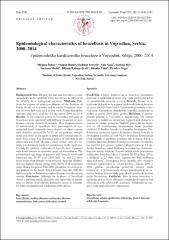| dc.description.abstract | Background/Aim. Despite the fact that brucellosis occurs
sporadically in the epidemic form, this disease is still one of
the world's most widespread zoonoses. Methods. Data
from the register of infectious diseases of the Institute of
Public Health of Vojvodina and Scientific Veterinary Institute
in Novi Sad were used in this study. Using descriptive
statistics, data were analyzed for the period 2000 to 2014.
Results. In the observed period in Vojvodina 102 cases of
brucellosis were registered with different frequency of notification
cases by districts of province. Most frequent modes
of transmission of brucellosis were consumption of contaminated
food (especially sheep cheese) or direct contact
with domestic animals. In 70.2% of the patients, occupational
exposures to the agent or direct daily contact with animals
were noted. The dominant source of infection in the
urban area was food, whereas a direct contact with sick animals
was dominant mode of transmission in the rural area.
Overall, 14 epidemic outbreaks of brucella were registered
with direct contact as dominant mode of transmission. The
predominant age-range of patients with brucella confirmed
infections was 30–59 years (50.0 male %), and 2.5 times
more males than females were affected. Seasonal distribution
was highest during spring, with 50.0% of all confirmed
cases. During the period 2004–2005, prevalence of serum positive
patients in the South Bačka District coincided with the
highest number of laboratory confirmed serum samples among
animals. Conclusion. Although the incidence of brucellosis
shows a declining trend, education and improving of surveillance
of disease of all relevant institutions seems as necessary
for better recognition and notification of the disease. | en_US |

